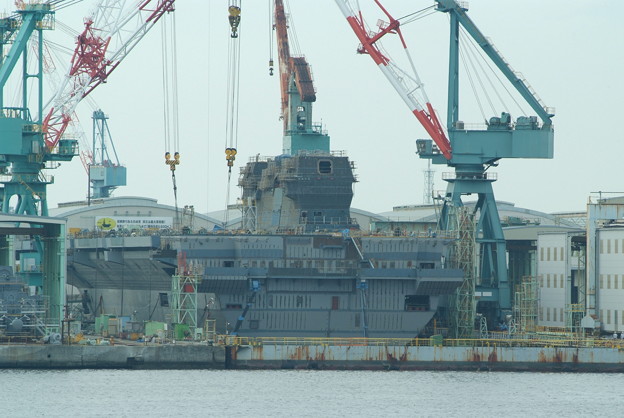 Recent commentary, including by Phil Radford here on The Strategist, has argued that Japan’s new Izumo (DDH22) ‘flat top destroyer’ is in fact the Maritime Self-Defense Force’s (MSDF) first, ‘mid-sized aircraft carrier’ since the Second World War. That’s because the 27,000 ton (full displacement) ship features a 248 metre flight deck which could be reconfigured to carry up to 12 F-35B, short take-off/vertical landing (STOVL) Joint Strike Fighters. In this view, the operational role of this ‘light aircraft carrier’ would be to provide air defence over the disputed Senkaku/Diaoyu Islands or even strikes against the Chinese mainland. In other words, the ship is about ‘upping the ante’ against Chinese maritime belligerence. But, while the Izumo certainly reflects a qualitative improvement for the MSDF, I’d argue that the ship doesn’t signal the return of the ‘Imperial Fleet’.
Recent commentary, including by Phil Radford here on The Strategist, has argued that Japan’s new Izumo (DDH22) ‘flat top destroyer’ is in fact the Maritime Self-Defense Force’s (MSDF) first, ‘mid-sized aircraft carrier’ since the Second World War. That’s because the 27,000 ton (full displacement) ship features a 248 metre flight deck which could be reconfigured to carry up to 12 F-35B, short take-off/vertical landing (STOVL) Joint Strike Fighters. In this view, the operational role of this ‘light aircraft carrier’ would be to provide air defence over the disputed Senkaku/Diaoyu Islands or even strikes against the Chinese mainland. In other words, the ship is about ‘upping the ante’ against Chinese maritime belligerence. But, while the Izumo certainly reflects a qualitative improvement for the MSDF, I’d argue that the ship doesn’t signal the return of the ‘Imperial Fleet’.
There’s an important distinction between ‘proper’ aircraft carriers, such as the Nimitz-class of the US Navy, the French Charles de Gaulle or the Chinese Liaoning, and large escort ships which can support STOVL jets but whose main purpose is either amphibious assault, such as the US Wasp-class, or antisubmarine warfare (ASW), and Japan’s Hyuga-class (16DDH) helicopter destroyer. Aircraft carriers allow for a larger range of air operations than a few jump jets. But even more important is their ability to perform a range of doctrinal roles that large escort ships can’t. Historically, such roles included: serving as the ‘eyes of the fleet’; as a ‘cavalry at sea’ to conduct hit-and run raids; as a ‘capital ship’ capable of defeating any other ship type; as a nuclear-strike platform; as an ‘airfield at sea’; and as a geopolitical chess piece. Most of these roles have become obsolete, and aircraft carriers are primarily used today as ‘airfields at sea’ to support land operations, as a symbol of national prestige and, more recently, to support humanitarian and disaster relief (HADR) operations.
Seen through this lens, the Izumo isn’t an aircraft carrier in any meaningful way. According to the Japanese Ministry of Defense, the ship’s purpose is to strengthen Japan’s ASW and HADR capability. It will be able to operate up to nine helicopters simultaneously on the flight deck (5 more than the 16DDH) and 14 helicopters in the hangar deck (3 more than the 16DDH). It can also carry up to 4,000 troops and 50 trucks. The Ministry also pointed out that the ship lacks offensive capabilities such as a ski-jump ramp, stating that the ‘ship will be incapable of having fighter jets land on and take-off from the deck, and we have no such intentions’.
There are reasons to believe this statement. Despite much media hype, Japan’s military posture remains inherently defensive. Strengthening its ASW capabilities in the face of increased Chinese submarine activities around the Senkaku/Diaoyu Islands and other areas of the East Sea makes perfect sense. In contrast, using the Izumo as an ‘airfield at sea’ to conduct offensive strikes with a handful of F-35Bs against Chinese forces or even the Chinese mainland is strategically and operationally a non-starter. This situation doesn’t change even if the MSDF acquires a sister ship. It’s also clear to MSDF planners that efforts to use the ships to establish ‘sea control’ in the face of China’s rapid progress in building sophisticated warships are futile. It should be noted that the unveiling of the Izumo was accompanied by an announcement that the total number of destroyers will be reduced by five over the coming years.
Furthermore, it’s often overlooked that Japan doesn’t operate on its own but relies predominantly on the offensive firepower of its US ally. Acquiring very expensive and operationally questionable offensive capabilities such as an aircraft carrier would unnecessarily undermine Japan’s standing in the region and would diminish its economic capacity to invest into a more capable force aimed at building a defensive parameter around disputed territories. Finally, in regards to Japan’s ability to patrol the skies over the Senkakus and other areas, it’d be more efficient to forward deploy land-based F-35As with support from tanker aircraft to allow for enough loitering time.
Semantics matter. Labelling the Izumo an aircraft carrier arouses unwarranted pictures of a more assertive Japan. True, the ship is a serious capability. But for Tokyo, acquiring offensive capabilities of this kind doesn’t make sense politically, strategically, operationally and economically. Even if Tokyo decides to put F-35Bs on its Izumo escort—and there are no indications for such a development—they’d realistically only be used to support Tokyo’s new, yet inherently defensive, ‘dynamic defense force’ concept.
Benjamin Schreer is a senior analyst at ASPI.

